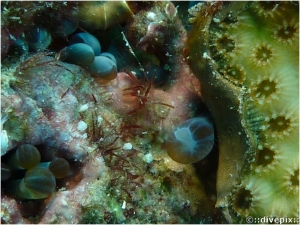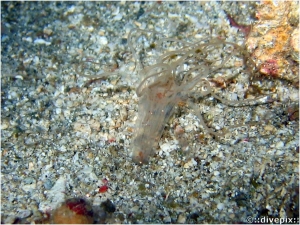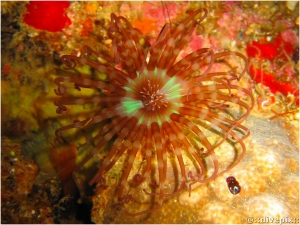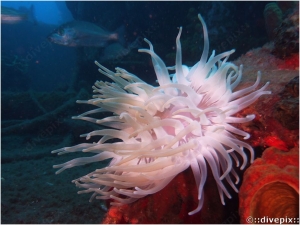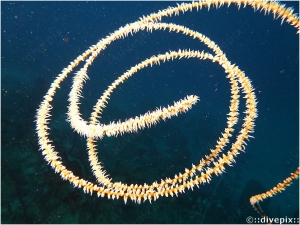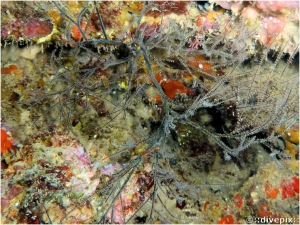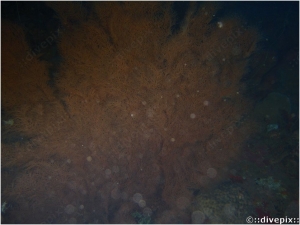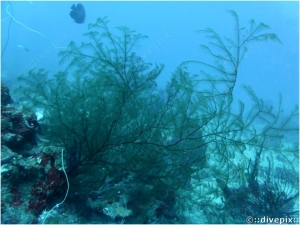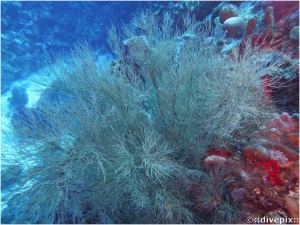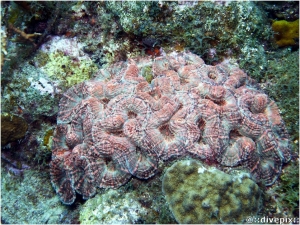




Eric H. Biass
Banded Tube-Dwelling Anemone
Giant Anemone
| Aspect: | A mass of blunt or bulb-tipped tentacles arranged in several rows around the top surface of a stout and squatting cylindical body, but leaving a clear area (the oral disc) at the centre of which is the mouth, which can be seen on some of the photos below. Colours can vary considerably. As with all polyps, the role of the tentacles is to sting small organisms and bring them to the central mouth (one of the photos shows a tentacle bent back over to the mouth to do just that). |
| Population: | Very common |
| Notable feature: | Home to a number of creatures, mainly shrimps like the Squat Anemone Shrimp (q.v.) and the Sun Anemone Shrimp (q.v.) that are immune to the poisoning effect of the tentacles' nematocysts. |
| Environment: | Usually found in semi protected areas at the foot of a boulder or typically on a wreck, on the angle of a floor surface and a bulckhead. |
| Behaviour: | Ignores divers even if approached closely. May have a stinging effect if touched. |
Wire Coral
| Aspect: | Looks like a single (no branches) barbed wire winding its way up into the water. The "barb" is in fact a dense pattern of radially deployed polyps along the central structure of this black coral. |
| Population: | Common, usually on the slopes of deep-plunging reefs. |
| Notable feature: | Looks dark overall, but under flashlight reveals a brown or orange stem form which a continuous stream of white polyps radially protrudes. |
| Environment: | Generally along reef slopes from 20 metres on. |
| Behaviour: | Polyps retract if accidentally touched. |
Scraggly Black Coral
| Aspect: | Small dark bush of disorderly and randomly growing scraggly branches with the smaller stalks hosting radially extending conical polyps typical of black coral. |
| Population: | Common. |
| Notable feature: | Black or dark grey stems and secondary branches. |
| Environment: | Rocky areas |
| Behaviour: | - |
Feather Black Coral
| Aspect: |
Tends to grow in a single plane like a Sea Fan (which it is not) rather unlike the other common black coral in the area, the Bushy Black Coral (q.v.). Branches and secondary branches grow pinnately. The secondary branches are those that carry most of the polyps, which radially deploy their translucent tentacles. Rather than black, branches are lighter in colour, ranging from orange to dark brown. Unlike other corals, stony in particular, Black Corals do not form polyp coralites as such, with polyps each developing a system of radial tentacles. These do contract when needed, but cannot completely retract within the branch structure. NOTE: Black Corals owe their name to the fact that their branches exsude a dark coloured protein, which builds up in successive concentric layers. |
| Population: | Common around Ilets Pigeon, a protected area. |
| Notable feature: | Branches are covered in white-ish radially spoking polyps (very reminiscent of wire coral [q.v.] in that respect). |
| Environment: | Generally found at 10 metres or deeper. Usually grows upwards from a solid rocky base to a height of around one metre. |
| Behaviour: | Polyp tentacles contract (as oppposed to retract) when touched. |
Bushy Black Coral
| Aspect: |
Bushy mass of seemingly disorderly branching colonies, that first appears as a light grey mass to the approching diver when the white-translucent polyp tentacles are fully deployed. Unlike Feather Black Coral (q.v.) secondary branchlets grow off their main branches in no particular order. Rather than black, branches are lighter in colour, ranging from orange to dark brown. Unlike other corals, stony in particular, Black Corals do not form polyp coralites as such, with polyps each developing a system of radial tentacles. These do contract when needed, but cannot completely retract within the branch structure. NOTE: Black Corals owe their name to the fact that their branches exsude a dark coloured protein, which builds up in successive concentric layers. |
| Population: | Common around Ilets Pigeon, a protected area. |
| Notable feature: | Dark stems and branches (brown) covered in white-ish radially spoking polyps (very reminiscent of wire coral [q.v.] in that respect). |
| Environment: | Usually found at 20 metres or deeper. Can grow upwards from a solid horizontal base, or cascade off a cliff or a wreck hull (as seen in one of the pictures included in this entry) to reach a height of two to three metres. |
| Behaviour: | Polyp tentacles contract (as oppposed to retract) when touched. |
Spiny Flower Coral
| Aspect: | Appears as a solid and unique mass of large (up to 8cm diameter) meandering corallites (which are the hard surrounding walls of polyps), but are in fact separate fleshy polyps so closely bunched up together that they look like a solid mass reminiscent of a brain coral (see pictures of "Smooth Flower Coral" to better understand the concept of separate polyps on a common colony base). The name derives from the skeleton of each septum the edges of which are deeply serrated blades (which can only be seen on dead animals). Although colours can be more generally grey, or even blue elsewhere, many of the specimens photographed in this region appear to combine orange and green giving them an overall pinkish marmorean appearance from a distance. |
| Population: | Common. |
| Notable feature: | Transulcent polyps only deploy at night. |
| Environment: | Rock substrates, at depths of between 5 and 40 metres. |
| Behaviour: | - |



